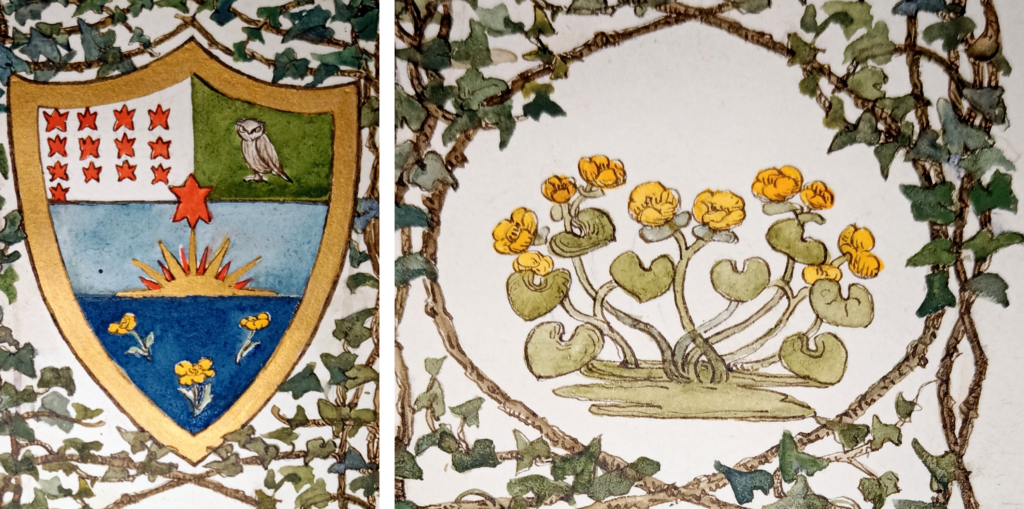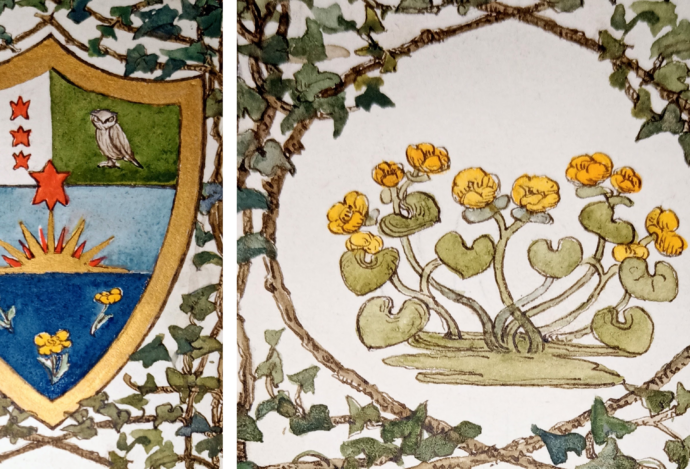Dr Jean Lambert, Honorary Archivist and Life Fellow, delves into the archives of Hughes Hall once again and comes up with a lively account of one of the college’s earliest societies.
This article was originally published in the Hughes Magazine and is shared again to mark 138 years since the inauguration of the College at its founding Committee Meeting at 3 Newnham Terrace in Cambridge on 9th May 1885.
Miss E M Wilmot Buxton, alumna of this college and schoolmistress at Brighton High School for Girls, proposed the idea of the Marsh Marigold Tramp Club (MMTC) in the autumn of 1893. She suggested the club’s aim was to encourage ‘acquaintance with one’s native land’ – an aim that would surely chime with many of us with the recent travel restrictions. One or more tramps lasting a week or ten days and conducted on strictly economic principles were to be undertaken annually. Locations might include the Weald of Kent and Dartmoor.
The use of the word ‘tramp’ rather than ‘walking’ or ‘hiking’ is unusual though unsurprising, since doing things differently is a Hughesian tradition. (Compare the use of ‘gild’ for the college’s alumnae association.) But exactly what was meant by ‘tramp’ is not explained. A heavy or forcible tread? A stamp, trudge or march? Or a long, tiresome walk?

College crest designed by students in the 19th century featuring the marsh marigold; and Marsh marigolds painted on the title page of the commemorative volume students made for Miss Hughes in 1899
Conversely, the choice of ‘marsh marigold’ presents no such problem. The golden marsh marigold grew in abundance along the Cam and in the nearby water meadows surrounding the college’s first home in Newnham. By 1893, it had been adopted as the college flower and is emblematised in the earliest version of the college crest, which was probably designed by students. The marsh marigold was especially appropriate for the Tramp Club given Miss Hughes’s practice of accompanying each new student on a long walk through Grantchester Meadows for the purpose of getting to know her better.
Unfortunately, there appears to be no extant record of the MMTC tramps undertaken in the native landscape. There is, however, a vivid description of the redoubtable Miss Wilmot Buxton leading a party of students on a three-week trip to the High Alps
during the Easter vacation of 1894.
A whirlwind tour
Seven cloaked females disembark on the steamer from Newhaven. Paris is the first stop on their itinerary. Under a blazing sun, they proceed at a rapid gallop through streets and buildings, glimpsing the majesty of Notre-Dame, the beauty of the de Milo ‘Venus’, and a tall column marking the spot where the voracious guillotine once stood.
After two nights of sleepless travel, they arrive, begrimed and disheveled, in Berne. Here they study the grand (albeit cold and grimy) buildings and refresh their weary souls with sweet music from one of the finest cathedral organs in Europe. The party note quaint old streets and al fresco activities, rollicking bears, and the great wooden clock with its absurd cock flapping its wings and crowing on the hour.
Steep ascents; painful descents
The Lauterbrunnen Valley delivers their first vivid picture of blue lakes and snowy peaks, with the Jungfrau, Black Monk and Breithorn rising above. A steep, steep climb brings them to Gimmelwald at the head of the valley, where the seven stern and ruthless females, armed with slippers, frantically try to exterminate earwigs from their lodgings. More exciting – and certainly more fun! – the party avalanche in a human caterpillar at terrific speed down the snowy slope of the Schilthorn. Several steep ascents follow. Wearing nailed boots, short skirts and straw hats, they process in single file up a seemingly endless succession of steeper and steeper heights, each one tantalisingly hiding their destination. ‘It’s always the next hill but one’ declares the infant of the party despairingly; another bemoans seven hours without food. At the summit of Roth Tal seven women, too weary to take in the picturesque scenery, sleep soundly in the sunshine. Below
lies the blue glacier. Sunlight adorns the tops of the fir trees, the gleaming waters of the falls and the foaming river winding its way along the base of the mountains.
Their short respite is followed by painful descents over grassy, stony slopes, reducing the boot of one student to a shapeless leathern mass, its owner to agony. An adventurous member of Miss Wilmot Buxton’s party inadvertently avalanches; others descend rather more sedately. The penultimate scene is one of panic as railway tickets and purses are temporarily mislaid. But all’s well
that ends well: safely back on board the steamer, heaps of rugs and seven disheveled human beings are scattered about on deck, homeward bound
Today Hughes Hall has around 30 clubs and societies, where students can participate in everything from handball to knitting. Miss Wilmot Buxton would be gratified to know that one of these is devoted to casual climbing/bouldering, with a regular climbing slot on Saturdays and outdoor bouldering trips when possible.
This article can be read in the Hughes Magazine, edition 32: www.hughes.cam.ac.uk/academic/hughes-magazine.
10.5.23





